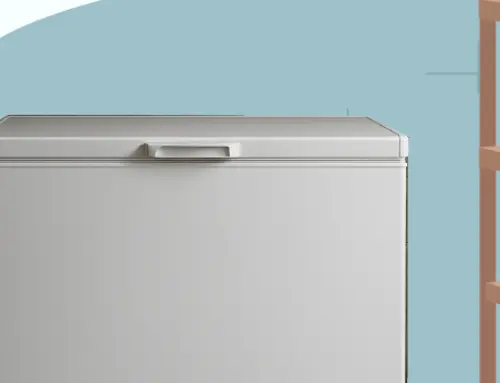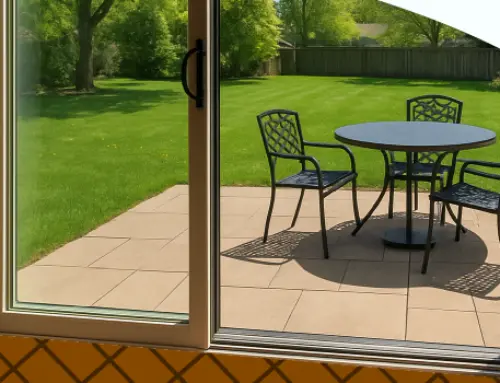What Are the Dimensions of a Standard Size Refrigerator? (And How It Affects Your Power Bill)
by Jenna Mendez
18.1 min read

Ever tried to squeeze a new fridge into your kitchen only to realize it doesn't fit, or worse, your energy bill suddenly spikes after you finally get it running? You're not alone. Whether you're upgrading appliances, moving into a new home, or simply trying to make your kitchen more efficient, figuring out the right refrigerator size can be trickier than it seems.
Understanding refrigerator dimensions isn't just about making sure it fits between cabinets; it also affects how much electricity your home uses every day. At Santanna Energy Services, it's our job not only to supply energy but to help find new ways to make our customers' homes more energy efficient.
That's why in this guide, we'll break down the dimensions of a standard size refrigerator, how to measure your space correctly, and how the size you choose can impact your power bill. With a little know-how, you'll save both space and energy. Let's get started.
Key Points of This Article:
- According to Maytag, most refrigerators measure 24 to 40 inches wide, 62 to 72 inches tall, and 29 to 36 inches deep.
- Upgrading to a 28-cubic-foot model could increase energy use by 200 to 250 kWh a year, costing $35 to $45 more annually.
- Common styles like top-freezer, bottom-freezer, side-by-side, French door, and four-door refrigerators each have unique space and storage needs.
- Choosing an ENERGY STAR-certified model can make your fridge up to 9% more efficient, keeping food fresh and energy bills lower.
How To Measure for a New Refrigerator
Buying a new refrigerator is exciting, but before you pick your favorite model, it’s important to make sure it will actually fit in your space.
Measuring correctly BEFORE you make your purchase or start looking at models prevents costly installation issues and helps your refrigerator run more efficiently. Taking a few extra minutes to measure the width, height, depth, and airflow space of the fridge you’re looking to replace or the space you’re looking to fill can save you headaches later on.
Step 1: Select Your Refrigerator Style
Before you start measuring, think about how you use your kitchen. Common styles include top-freezer, bottom-freezer, side-by-side, French door, and four-door refrigerators. Different refrigerator styles not only change the look of your kitchen, they also impact how much clearance you’ll need for doors, drawers, and walking space.
For example, side-by-side and French door models are wider, while top-freezer styles are typically narrower and taller. Once you know the type of refrigerator that fits your lifestyle, you’ll have a better idea of how much space to measure, including door swing, hallway clearance, and space for ventilation.
Step 2: Measure for Refrigerator Width
Start by measuring the space between your cabinets or walls. Most standard refrigerators are 24 to 40 inches wide. Be sure to use a tape measure to find the exact width of your opening and leave about 1 inch of space on each side to account for ventilation and a little bit of wiggle room for easy installation.
Step 3: Measure for Refrigerator Height
Next, measure from the floor to the bottom of your upper cabinets. Refrigerators usually range from 62 to 72 inches tall. But be sure to leave at least 1 inch of clearance above the fridge so heat can escape, which helps your fridge compressor work efficiently and keeps your appliance running smoothly.
Step 4: Measure for Refrigerator Depth
Depth affects both how far your fridge will stick out and how well your fridge doors will open. Standard-depth for the most common types of fridge models are 29 to 36 inches deep, while counter-depth refrigerators are shallower at 24 to 30 inches, giving your kitchen a built-in look.
If you have a kitchen island, make sure you leave enough room for the doors to swing open fully without hitting anything.
Step 5: Check Door Clearance Before You Buy
Refrigerator doors need space to open all the way. To get an accurate measurement of your door clearance, measure the area in front of your fridge and allow at least 2 to 3 inches of clearance on each side for hinges and handles.
If your refrigerator is near a wall or corner, double-check that both doors can open wide enough for drawers to slide out comfortably.
Step 6: Include Handles in Your Depth Measurement
Handles add extra depth that measures up to 2 or 3 inches. Include them when measuring, especially if your refrigerator will sit near a walkway or island. This helps you avoid a fridge that sticks out too far and disrupts your kitchen flow.
Step 7: Adjust Measurements for Ventilation Space
Refrigerators need room to breathe. GE Appliances recommends at least 1 inch of space at the top and back for proper airflow. Without this ventilation, the compressor has to work harder, which can shorten your fridge’s lifespan and increase energy use.
Step 8: Calculate Refrigerator Capacity in Cubic Feet
Capacity tells you how much food your refrigerator can hold.
To estimate your refrigerator’s capacity, multiply width × height × depth (in inches) and divide by 1,728 to convert to cubic feet. F
or example, a refrigerator that’s 35 inches wide, 70 inches tall, and 30 inches deep equals about 42.7 cubic feet total space, though the usable interior will be smaller once shelving is added.
Step 9: Map Out and Measure a Path for Refrigerator Delivery
Don’t skip this step! Before delivery day, measure all doorways, hallways, and stairways between your entryway and kitchen.
Standard refrigerators are 28 to 36 inches wide, but tight corners or narrow door frames can cause problems with moving the unit into your home. Make sure there’s enough room for movers to transport the appliance into its designated spot safely without removing doors or damaging walls.
What Are the Most Common Sizes and Dimensions of a Standard Size Refrigerator?
When people talk about a “standard refrigerator size,” it doesn’t mean there’s one exact measurement. It simply refers to the typical range most full-size refrigerators fall into.
According to appliance giant Maytag, most standard models measure 24 to 40 inches wide, 62 to 72 inches tall, and 29 to 36 inches deep.
Below, we’ve done the research and pulled together a list of the most common refrigerator types and their sizes to help you compare and find one that fits your kitchen and energy goals.
Always remember that sizes can vary slightly depending on the model and manufacturer.
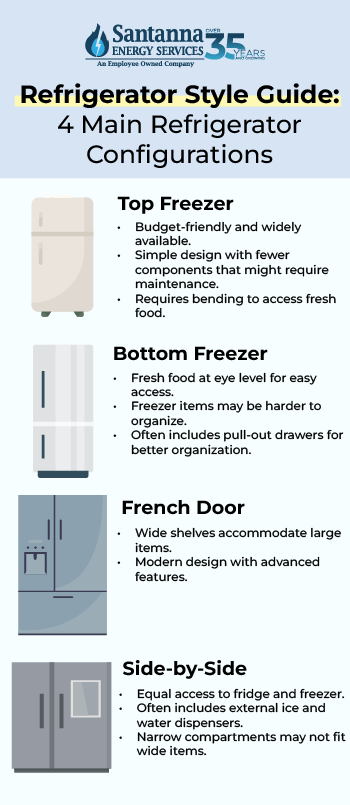
French Door Refrigerator Dimensions
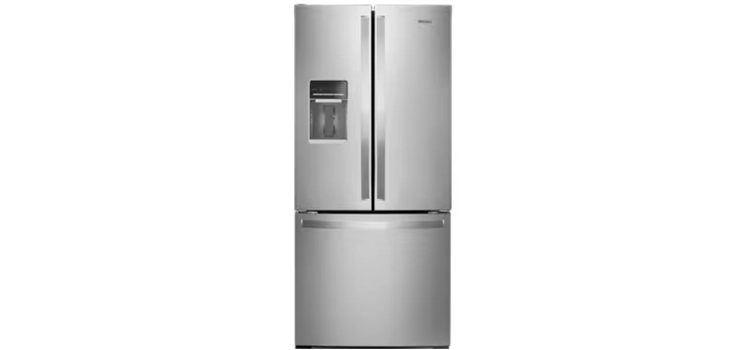
French door refrigerators come with two doors on top and a pull-out freezer below, combining style and practicality. They’re a great fit for families who like a modern, open design and want their most-used fresh foods right at eye level for easy access.
Dimensions: 29–36 inches wide, 68–70 inches tall, and 29–35 inches deep
Pros:
- The spacious interior offers flexible storage and wide shelving, making it easy to arrange food and containers.
- It’s great for organizing large platters, party trays, and bulk groceries.
- The energy-efficient double-door design helps reduce how much cold air escapes when you open one side.
Cons:
- French door refrigerators are generally more expensive than other styles.
- Their larger size can be difficult to fit in smaller kitchens or tighter layouts.
- The bottom freezer drawer requires more bending to reach frozen items, which may not be convenient for everyone.
A good example of this size is the Whirlpool 30-inch Wide French Door Refrigerator. This 30-inch wide model stands 67-3/8 inches high and 34-3/8 inches deep, offering purposefully designed storage zones for frequently used items.
This model is thoughtfully designed with convenient storage zones for everyday items, humidity-controlled crispers to keep produce fresh, and adjustable gallon door bins that make organizing easy. While these measurements reflect a standard size, exact dimensions can vary slightly depending on the model and brand you choose.
4-Door Refrigerator Dimensions
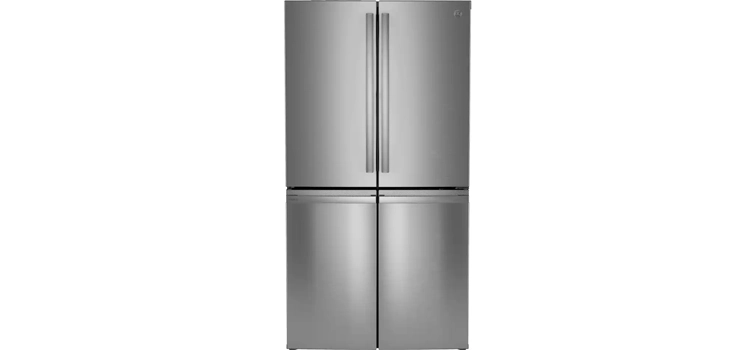
These models feature two doors on top for the refrigerator and two compartments below, often including a convertible section that can switch between fridge and freezer mode. Four-door refrigerators are designed for families who want extra flexibility and organization in their kitchen.
This setup makes it easy to separate groceries by category, perfect for households that meal prep, buy in bulk, or like to keep drinks and snacks in their own designated space.
Dimensions: 35–36 inches wide, 69–72 inches tall, 28–30 inches deep
Pros:
- These refrigerators offer customizable temperature zones, allowing you to adjust compartments for fresh or frozen storage as needed.
- They provide excellent organization for large households, making it easier to keep different food categories separated and accessible.
- The sleek, premium design often includes smart connectivity features for added convenience and modern control.
Cons:
- Four-door refrigerators typically come with a higher initial cost compared to other styles.
- They are heavier and may require reinforced flooring or careful placement during installation.
- The wide doors need extra clearance to open fully, which can be a challenge in smaller or tighter kitchen layouts.
To give you an idea, the GE Profile 22.9 Cu. Ft. 4-Door French Door Counter-Depth Smart Refrigerator stands at 69 ⅞ inches tall and 35 ⅝ inches wide. This model blends smart technology with a sleek, modern design, featuring temperature-controlled zones and a handy Dual-Dispense AutoFill pitcher that fills itself automatically. Its counter-depth build gives it a seamless, built-in look that’s perfect for tech-savvy homes.
While this refrigerator represents the standard size for this style, keep in mind that dimensions can vary slightly depending on the brand and added features.
Side-by-Side Refrigerator Dimensions
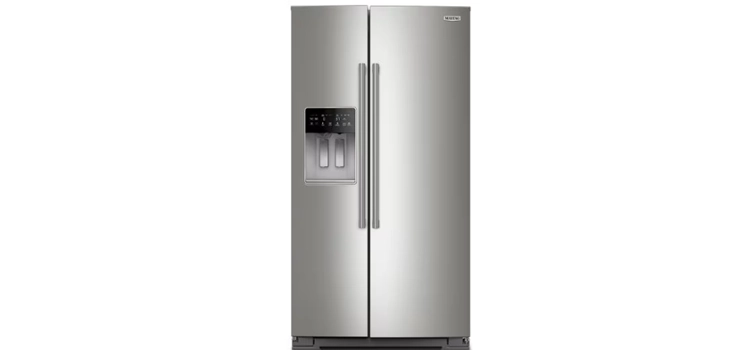
Side-by-side refrigerators have two vertical doors, one for the fridge and one for the freezer, giving you convenient access to both fresh and frozen foods at the same time. This layout is great for families who like to keep their groceries well organized or for anyone who stores a mix of frozen meals and fresh ingredients.
It’s also a smart choice for kitchens with limited space since the narrow doors don’t swing out as far as other styles, making them ideal for galley kitchens or layouts with islands.
Dimensions: 32–40 inches wide, 65–72 inches tall, 28–32 inches deep
Pros:
- These refrigerators offer balanced storage for both the fridge and freezer, making it easy to organize fresh and frozen foods side by side.
- The narrow doors save space, making this design ideal for smaller or galley-style kitchens.
- Bright LED lighting provides excellent visibility, so you can quickly find what you need without wasting energy.
Cons:
- The narrow shelves can make it difficult to store wide containers or large platters.
- Side-by-side models typically use slightly more energy than top-freezer refrigerators.
- The built-in ice maker can take up valuable freezer space, reducing overall storage capacity.
A model that represents this category well is the Maytag 36-inch Wide Counter-Depth Side-by-Side Refrigerator. This refrigerator measures 35-½ inches wide, 69-¼ inches tall, and 28-⅜ inches deep, right in line with standard side-by-side measurements. Keep in mind that specific models may differ slightly depending on design and capacity.
Top-Freezer Refrigerator Dimensions

This classic design remains a favorite for smaller homes and apartments. With the freezer on top, it provides reliable cooling and usually consumes less energy. The compact footprint fits most kitchens easily, but bending to reach lower shelves can be inconvenient for some users.
This style is perfect for individuals, couples, or small families who want an affordable, space-saving refrigerator that’s simple to maintain and energy efficient.
Dimensions: 28–33 inches wide, 61–67 inches tall, 28–35 inches deep
Pros:
- Top-freezer refrigerators are budget-friendly and energy-efficient, making them a great option for cost-conscious homeowners.
- Their simple, reliable design fits easily into smaller kitchens and provides dependable performance for everyday use.
- Many newer models feature a sleek, modern look with smart energy-saving functions that help reduce electricity use.
Cons:
- Accessing fresh foods often requires bending, which may not be convenient for everyone.
- Storage flexibility is limited compared to larger or more advanced refrigerator styles.
- This type of refrigerator typically offers fewer premium features or high-end design options.
One of the most common examples you’ll find in this range is the Samsung refrigerator measures 28 ¾ inches wide, 66 ¾ inches tall, and 31 ⅞ inches deep, making it ideal for compact kitchens. This model is within the standard size range, but keep in mind that actual dimensions can vary by manufacturer, especially with add-ons like ice makers or energy-saving features.
Bottom-Freezer Refrigerator Dimensions
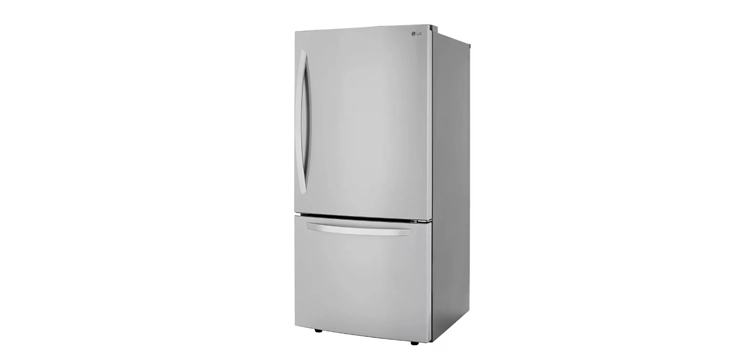
Bottom-freezer models flip the traditional layout by keeping fresh food at eye level and frozen food below. This setup improves everyday convenience, but since freezers pull out as drawers, you’ll need to account for extra clearance in front when measuring your space.
This style is great for families or individuals who use the refrigerator section more often than the freezer. It’s also a good fit for anyone who prefers a modern, organized layout that balances energy efficiency with easy access to fresh food.
Dimensions: 29–37 inches wide, 67–70 inches tall, and around 35 inches deep
Pros:
- The design offers convenient access to fresh food at eye level, reducing the need to bend or crouch when reaching for everyday items.
- Many models are ENERGY STAR® certified, ensuring they operate efficiently and help lower long-term energy costs.
- The sleek and durable exterior provides a modern look that complements a variety of kitchen styles.
Cons:
- The pull-out freezer drawer requires more space in front for full clearance, which can be challenging in smaller kitchens.
- Bottom-freezer models generally cost slightly more than traditional top-freezer options.
- These refrigerators tend to be heavier, making them more difficult to move or reposition once installed.
An example for this type of refrigerator is the LG model which measures 36.5 inches wide, 69.88 inches tall, and 35 inches deep, placing it within the standard bottom-freezer range. It offers Door Cooling+ and Multi-Air Flow systems that keep food evenly chilled, plus a smudge-resistant stainless-steel finish. While this fits the typical range, sizes may vary slightly across brands and configurations.
What Are the Dimensions of a Standard Apartment Size Refrigerator?
According to Whirlpool, most apartment refrigerators are about 24 inches wide, compared to 30–36 inches for standard models, and stand between 60 and 75 inches tall. Despite their slimmer design, they still offer generous storage, typically 11 to 13 cubic feet, which is much more space than a mini or dorm fridge. Apartment-size refrigerators are designed for smaller kitchens, condos, and studio spaces where a full-size model won’t fit.
Because space is limited, if you’re looking into a replacement fridge, measuring carefully is essential. Be sure to leave at least 1 inch of space on the sides and a few inches on top and behind the fridge for proper airflow. Many apartment-size models come in top-freezer or bottom-freezer styles, and some feature sleek counter-depth designs for a built-in look.
Choosing the right size helps you save energy, reduce clutter, and make the most of every square foot in your kitchen.
What Size Refrigerator Do I Need? Our Guide to Help
Choosing the right refrigerator size isn’t just about how much space you have in your kitchen. It’s also about how much food your household typically stores. Below are general guidelines to help you find the right fit for your household:
The Best Refrigerator for 1 to 2 People
For singles or couples, a top-freezer or bottom-freezer refrigerator is usually the best choice. These models offer a good balance between storage and energy efficiency without taking up too much floor space.
The ideal capacity for a smaller household is 14 to 18 cubic feet, which typically measures about 28 to 30 inches wide and 60 to 66 inches tall.
If you live in an apartment or condo, you might consider an apartment-size refrigerator with around 11 to 13 cubic feet of storage. It’s compact but still provides enough room for your groceries. Those who cook often or meal prep should go for the higher end of this range to avoid running out of space.
The Best Refrigerator for 3 to 4 People
For an average family of three or four, a side-by-side or French door refrigerator works best. These models usually range from 18 to 22 cubic feet, with dimensions around 30 to 33 inches wide and 65 to 70 inches tall. They provide flexible shelving, wide door bins, and easy access to both fresh and frozen items, which makes organization a breeze.
If you tend to shop in bulk or store large containers, look for adjustable shelves and bins. This size offers enough space for weekly groceries, beverages, and leftovers without sacrificing efficiency or taking up too much room in your kitchen.
The Best Refrigerator for 5 or More People
Larger households with five or more people need a refrigerator with at least 22 to 30 cubic feet of space, which is typically 33 to 36 inches wide and 68 to 72 inches tall. A French door or 4-door refrigerator is ideal for this group because it offers deeper storage, wide shelving, and multiple compartments to keep everything organized.
Since bigger refrigerators use more energy, it’s worth choosing an ENERGY STAR-certified model to help offset electricity costs while maintaining top performance. These models are built for efficiency, so you get the large capacity you need without seeing a big jump in your power bill.
What Is the Most Energy-Efficient Refrigerator Size?
According to ENERGY STAR, the larger the refrigerator, the more energy it typically consumes. That’s because bigger units require more power to keep a larger space cool. The most energy-efficient refrigerator sizes are usually between 16 and 20 cubic feet, which offer a good balance between storage capacity and energy use.
These mid-sized models are ideal for small to medium households that want enough space for groceries without driving up their electric bill. If you have a larger family and need more room, choosing an ENERGY STAR-certified model can still help offset the extra energy use.
These certified refrigerators use advanced insulation, efficient compressors, and temperature controls that keep your food fresh while lowering electricity costs over time.
How Your Refrigerator Size Affects Your Electricity Bill and How the Wrong Size Can Cost You
Your refrigerator runs 24 hours a day, 7 days a week, making it one of the most energy-hungry appliances in your home. That’s why the size of your refrigerator matters more than most people realize. The larger the unit, the more air space there is to keep cold, and the harder your compressor has to work to maintain temperature.
Conversely, a fridge that’s too small can get overloaded, restricting airflow and forcing it to run longer cycles to stay cool. Both situations can drive up your electricity costs over time.
For example, the Frigidaire 20 Cu. Ft. Garage Ready Top Freezer Refrigerator uses about 427 kilowatt-hours (kWh) per year, or roughly 36 kWh per month. At an average electricity rate of 17.47 cents per kWh, this comes out to about $6.29 per month or around $75 per year to operate. While that may seem reasonable, upgrading to a larger 28-cubic-foot model could increase your energy use by 200 to 250 kWh annually, adding $35 to $45 more to your yearly bill.
On the other hand, a fridge that’s too small for your household can cost you in other ways. Overpacking limits airflow, causing the compressor to work harder and increasing energy use by up to 15–20% more per year compared to a properly sized model. It can also shorten the lifespan of your appliance due to constant cycling and strain on the motor.
In short, a refrigerator that’s too big means you’re cooling empty space and wasting energy, while one that’s too small runs nonstop to stay cold. Choosing the right size and opting for an ENERGY STAR-certified model keeps your fridge operating up to 9% more efficiently, your food fresher, and your power bills predictable all year long.
What Size Extension Cord Do I Need for My Refrigerator?
Refrigerators draw a significant amount of power, which is why most experts and manufacturers strongly advise against using an extension cord to run them. According to LifeSupplyUSA, refrigerators require a dedicated power source that can handle at least 15 amps of current. Most standard three-prong cords or household extension cables aren’t designed for that kind of sustained load.
If you absolutely must use one for a short period, choose a heavy-duty 10-gauge cord rated for 15 to 20 amps, and make sure it’s as short as possible, never longer than 10 feet. Using a cord longer than that, especially over 50 feet, increases the risk of voltage drops, overheating, or electrical fires because power weakens the farther it travels.
In the long run, the safest and most efficient solution isn’t a cord at all, it’s a new outlet. If your refrigerator’s plug doesn’t reach, hire a licensed electrician to install an outlet nearby. This ensures your fridge runs efficiently, keeps your food safe, and eliminates the risk of electrical hazards in your home.
Finding the right refrigerator size isn’t just about making sure it fits between your cabinets. It’s about choosing a model that supports your lifestyle, keeps food fresh efficiently, and helps manage your home’s energy use.
Whether you’re upgrading to a French door design or picking a compact model for a smaller space, understanding dimensions, capacity, and energy efficiency can make a big difference in your monthly costs and long-term comfort.
If you want to take that same control over your home’s energy use, our Unlimited Energy plan gives you a predictable supply charge no matter how much electricity your appliances use,* so you can enjoy peace of mind all year long without worrying about seasonal supply charge spikes.
Explore the Unlimited Energy plan today and discover a smarter, steadier way to power your home.
* Restrictions apply. Enrollment based upon program eligibility. Customers using more than 125% of normal monthly usage as determined by Santanna may be required to switch plans.
Jenna Mendez is a Midwest native with lifelong roots in Illinois and time spent in Ohio during college, giving her a deep understanding of the Midwest region’s people, climate, and energy needs. She brings firsthand experience and local insight to topics that matter to Midwest homeowners, especially energy efficiency, sustainability, and home living. Jenna specializes in writing about eco-friendly living, all things Midwest, renewable energy, and practical ways to reduce energy costs. Jenna brings a trusted, and local hometown voice to every article she writes, helping readers live well, and sustainably, right where they are.



